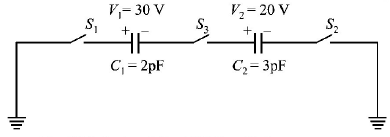Question
Two thin dielectric slabs of dielectric constants $${K_1}$$ and $${K_2}\left( {{K_1} < {K_2}} \right)$$ are inserted between plates of a parallel plate capacitor, as shown in the figure.
Two thin dielectric slabs of dielectric constants $${K_1}$$ and $${K_2}\left( {{K_1} < {K_2}} \right)$$ are inserted between plates of a parallel plate capacitor, as shown in the figure.

The variation of electric field $$E$$ between the plates with distance $$d$$ as measured from plate $$P$$ is correctly shown by
A.


B.


C.


D.


Answer :


Solution :
Graph (C) will be the right graph, the electric field inside the dielectrics will be less than the electric field outside the dielectrics. The electric field inside the dielectrics could not be zero.

As $${K_2} > {K_1},$$ the drop in electric field for $${K_2}$$ dielectric must be more than $${K_1}.$$
Graph (C) will be the right graph, the electric field inside the dielectrics will be less than the electric field outside the dielectrics. The electric field inside the dielectrics could not be zero.

As $${K_2} > {K_1},$$ the drop in electric field for $${K_2}$$ dielectric must be more than $${K_1}.$$

